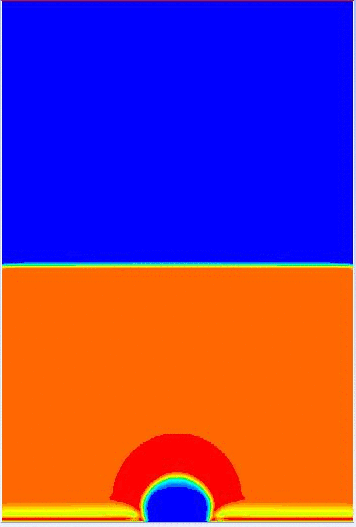Most of the industrial operations involve fluid as a media while mixing/separating the particles based on differences in their size, density and sometimes surface properties in the given slurry feed. These particulate multiphase flows involve complicated physical processes and complex geometry. Majority of these flows are even turbulent in nature. Therefore, the focus of our research is
-
On the development of Computational Fluid Dynamic (CFD) and Discrete Element (DEM) Models with additional forces (lift, drag, collisional etc..), shape factors along with rheology modification for accurate predictions in hydrocyclones, dense medium cyclones, fluidized beds, vertical pipe flows and mixing tanks etc.
-
Validating the CFD, DEM model predictions against in-house experimental measurements through laser, tomography and optical fibre probe techniques.
-
Virtual modification of the design parameters to improve the performance
-
Fabrication and testing of novel designs
-
ANSYS's CFD
-
ANSYS's ROCKY DEM
-
High-End Workstations - 2
-
2 X Intel® Xeon® Silver 4210R Processor (13.75 MB Cache, 10 Cores, 20Threads, 2.40 Ghz)
-
1 X 1TB M.2 2280 PCIe NVMe TLC SSD
-
128 GB DDR4 2999 ECC Reg
-
-
In-House Fabricated 100 mm Circular Fluidized Bed with Differential Pressure Transducer and Vortex Flow Meter
Dynamic Behaviour of Industrial Hydrocyclone (250 mm)
Here, the transitional/dynamic behaviour of a large-scale 250 mm hydrocyclone is predicted in terms of air core development and solid concentration distributions using the modified mixture model coupled with large eddy simulation turbulence model. Longer residence time is observed with near cut size particle compared to coarse and fine size particles. Further, the analysis of the equilibrium radius of the solid particles inside the cyclone in the presence of turbulence is compared with the classical Kelsall experiments and observed that the classification of particles influenced by both the turbulence dispersion as well as the centrifugal force. Finally, the effect of feed solids concentration (10-50 wt%) on the hydrocyclone performance and particle segregation is also undertaken in this study.


Air-core Solids Transition behaviour
Rheology based CFD Modelling for Coal Partitioning in Dense Medium Cylcones
This model approach uses the modified mixture model with the granular option and RSM to resolve the turbulent mixing of the particles. Rheological behavior of the medium is considered through non-Newtonian Herschel–Bulkley (HB) model corrected with particle loading and fraction of ultra-fines. Multiphase simulations with the HB model is able to predict the medium segregation, overall predicted product medium densities and underflow volume split close to the Gamma Ray Tomography (GRT) data, and the predicted medium viscosity levels are increased up to 18 cp. Lagrangian particle tracking is super imposed on converged medium simulations used for coal partitioning predictions.


Development of Novel Hydrocyclone Designs
Here, a set of potential hydrocyclone designs are explored for fines classification using CFD technique. The CFD model uses VOF multiphase model coupled with RSM for two phase flow predictions. Lagrangian Particle Tracking and ASM modified with shear lift forces and slurry rheology corrected with fines fraction are used to predict the particle classification. Predictions show that all the tested novel designs are inherently having the potential for finer cut separation and higher tangential velocity compared to the conventional design. The tested designs yielding high separation efficiency, smaller cut-point and minimum coarse particle misplacement due to resultant turbulence minimization.
CFD Modelling of fluidized beds
Granular option enabled Two-Fluid Model (TFM) coupled with different homogeneous and heterogeneous drag correlations (Gidaspow, Syamlal and O’Brien, Beetstra, Brucato, Gibilaro, EMMS, and Tenneti) are employed for the prediction of bubbling and turbulent fluidized bed flow characteristics. Numerically predicted results are validated against the literature-based experimental data in terms of bubble shape and diameter, axial and radial variation of time-averaged void fraction, pressure drop and bed expansion.


2D 3D

a. original image, b. grayscale (8 bit), c. processed image, d. outlined processing
